©2020 CLAREMONT HERITAGE • Website by Mindiwho Designs
 |
 |
- Home
- About Us
- Join / Donate
- Speakers / Events
- Tours
- Garner House / Rentals
- Archives / The Vault
- Resources
- Archives Research
- Claremont Trees Emergency
- Consultation: Historical Preservation
- Education: Third Grade Program
- Gabrielino Tongva
- Historical Preservation
- Lounge: Online Publications
- Preserving Our History
- Properties For Sale - Historic
- Oral History - Karl Benjamin
- The Mills Act
- Videos
- Preserving Citrus Heritage Foun
- Shop
- Contact
Gabrielino/Tongva
Native California Peoples
Photo Credit: California Missions Resource Center
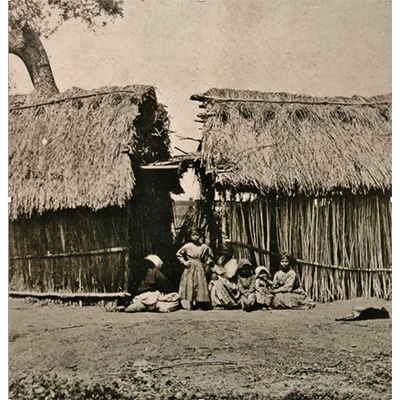 Gabrielino Huts |
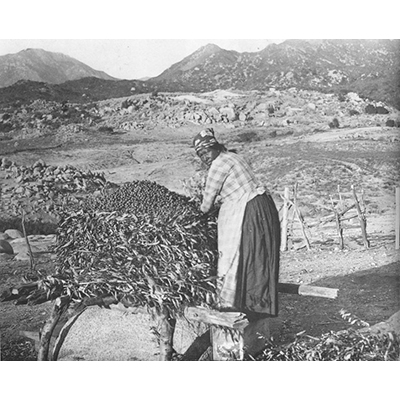 Gabrielino Acorn Granary Gabrielino Acorn Granary |
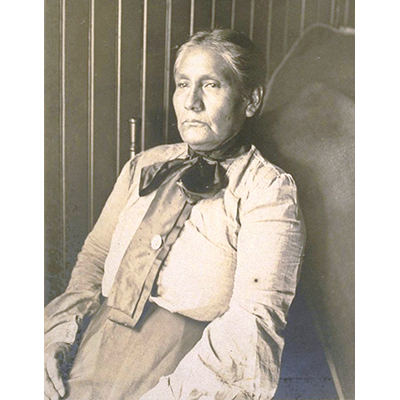 Mrs. James Rosemyre (nee Narcisa Higuera) |
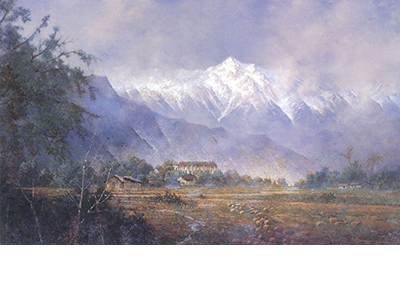 A Perspective View of San Gabriel Mission by Edwin Deakin |
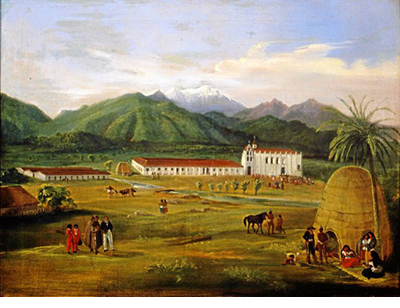 San Gabriel Mission circa 1832 |
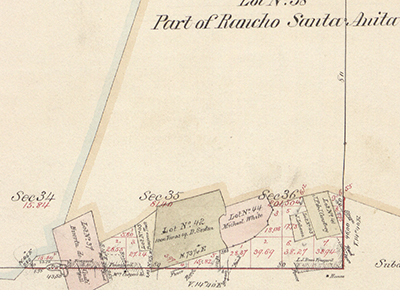 San Gabriel Tract near Courtney GLO 416 Lot 41 |
The Gabrielino/Tongva people are, in many ways, among the most interesting of native California peoples. The Gabrielino/Tongva occupied lands considered the most desirable sections of Southern California. This territory included the coastal lands, present-day Los Angeles and Orange County, and portions of present-day San Bernardino County. In the interior mountains and foothills, Gabrielino/Tongva settlement-patterns indicate the existence of both primary subsistence villages occupied continuously, and smaller secondary gathering camps occupied at various times during the year, depending upon season and resource. (Bean and Smith, 539) Settlements in the inland areas, including present-day Claremont, were situated near watercourses and artesian wells. The Gabrielino/Tongva were among the wealthiest, most populous, and most influential native groups in Southern California. Gabrielino/Tongva trade and influence spread as far north as the San Joaquin Valley Yokuts, as far east as the Colorado River, and as far as the southern territories of the Kumeyaay. Intra- and intergroup exchange was frequent. People and trade goods flowed freely and often for long distances. The Gabrielino/Tongva traded with bordering groups, including the Serranos, Cahuilla, Chemehuevi, Chumash, and Mohave. Gabrielino/Tongva trade items appeared as far as central Arizona. (Bean and Smith, 547) An important trade item, among the Gabrielino/Tongva and for export to other groups, was steatite or soapstone. The Gabrielino/Tongva traded steatite with many bordering groups, including the Chumash, Yokuts, Ipai-Tipai, Luiseño, Serrano, and via the Chumash to the distant Tubatulabal. As with trade, intra- and intercultural relationships were common. The Gabrielino/Tongva intermarried with the Yokuts, Chumash, Serrano, and Luiseño and developed close relationships with these surrounding groups. (Bean and Smith, 547) Nearly 100 villages existed prior to Spanish settlement. Population estimates of the Gabrielino/Tongva prior to missionization are based on village approximations by Juan Crespí (1721 – 1782). Crespí estimated that 50 to 100 persons inhabited each mainland village at the time of contact with Europeans. Other early Spanish reports indicate a range of per village population. However, Gabrielino/Tongva populations were likely already impacted by introduced European diseases resulting from contact with Spanish explorers in the mid-16th century. In 1771 Mission San Gabriel was established, one of two missions to which Spanish missionaries forcibly moved the majority of the Gabrielino/Tongva living in the San Gabriel and San Fernando Valleys. Missionization was an era of dramatic social and economic change, and continued exposure to European diseases. Gabrielino/Tongva populations dwindled due to introduced diseases, dietary deficiencies, and forced labor. At times, the Gabrielino/Tongva violently resisted Spanish rule, such as the 1785 rebellion led by the female chief Toypurina. During the 19th century, the Gabrielino/Tongva experienced rapid political and economic change. In 1821 Mexico gained its independence from the Spanish Empire, and the Mexican government sold mission lands to ranchers. In 1837 Governor Juan Bautista Alvarado gave a 22,340-acre land grant to Ygnacio Palomares and Ricardo Vejar, which they named Rancho San Jose. (Ogden) The present-day community of Claremont was located entirely within Rancho San Jose. In 1840, the Palomares, Vejar, and Luis Arenas, petitioned Governor Alvarado for additional grazing lands and received one square league addition, known as the Rancho San Jose Addition. As a result, the Gabrielino/Tongva shifted their labor practices to the California ranchos. Native rancherias continued to occupy the newly established Rancho San Jose boundaries. Archaeological evidence indicates that the Tongva settlement Tooypinga was in the area of Indian Hill and Foothill, near the present-day California Botanical Gardens. (McCawley 48 and Johnson 144-5) The rancheria of Tsikowale was in San Antonio Canyon (McCawley 48). Following the Treaty of Guadalupe of 1848, the California Land Act of 1851 required that holders of Spanish and Mexican land grants prove the validity of their ownership to the Public Land Commission. A claim for Rancho San Jose was filed with the Public Land Commission in 1852, and granted to Henry Dalton, Palomares, and Vejar in 1875. However, in 1865 the widow of Ygnacio Palomares had already begun to sell portions of the ranch land. In the early 1860s, the area experienced a flood, followed by several years of severe drought that profoundly affected herd populations and undermined the economy of the Rancho. Additionally, a smallpox epidemic spread throughout Rancho San Jose. The Gabrielino/Tongva of Claremont witnessed the demise of Rancho San Jose as the land was repeatedly sold, the rise and fall of the San Gabriel Valley's extensive citrus industry, and successive land booms and busts. During this period of economic turmoil, the Gabrielino/Tongva continued to adapt to the changing economy. Throughout, the Gabrielino/Tongva continuously worked for state and national recognition. From 1851 to 1853, U.S. Government Treaty commissioners signed 18 treaties that recognized the Gabrielino/Tongva. But these were never ratified by the U.S. Senate and were considered "lost." The 18 treaties were discovered in 1905, initiating a series of efforts to address the unceded lands of the Tongva. These efforts included the California Jurisdiction Act of 1928 that authorized the California Attorney General to represent the Tongva before the U.S. Court of Claims and the termination of 53 Native rancherias as part of the assimilation policies the 1950s. However, in 1994, the State of California officially recognized the Gabrielino/Tongva Tribe. On August 31, 1994, the state of California passed Bill AJR 96 which, in part, recognized the Gabrielino as "the aboriginal tribe of the Los Angeles Basin," recognized the entire Los Angeles Basin area and the Channel Islands ... as traditional Gabrielino/Tongva territory, and "respectfully memorializes the President and Congress of the United States to likewise give recognition to the Gabrielinos as the ancestral tribe of the Los Angeles Basin." (ca.gov) A California Senate Bill of 2008 (Senate Bill No. 1134) asserts that the U.S. government signed treaties with the Tongva and that these treaties were never ratified. On January 21, 2020, Assembly Member Ramos introduced Assembly Bill No. 1968 would, in part, authorize the owner or operator of any library or museum to adopt a land acknowledgment process "by which Native American tribes are properly recognized as traditional stewards of the land on which the… library or museum… is located, as specified." (ca.gov)
Further Information Artifacts are housed at institutions through the United States – Los Angeles Museum of National History, Santa Barbara Museum of Natural History, Lowie Museum of Anthropology at UC Berkeley, San Diego Museum of Us (Formerly the San Diego Museum of Man), Peabody Museum of Archaeology and ethnology, Field Museum of Natural History, Museum of the American Indian, and the Smithsonian Institute. |
CLAREMONT HERITAGE • 909.621.0848 • info@ClaremontHeritage.org
Located in the historic Garner House at Memorial Park, 840 N. Indian Hill Blvd, Claremont California
Mailing Address: PO Box 742, Claremont CA 91711